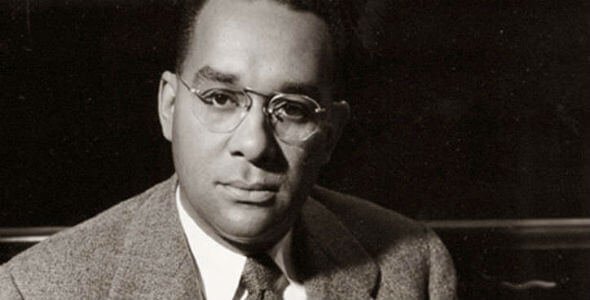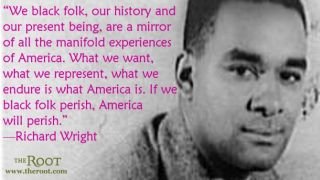Female Gender Roles in Literature (3/3)
Female Gender Roles in the Works of Katherine Anne Porter, Eudora Welty, and Richard Wright

Richard Wright Source
In this essay I will discuss,
The treatment of female gender roles in the works of three authors: Katherine Anne Porter, Eudora Welty, and Richard Wright. In reading Porter’s “The Old Order” and the character, Sophia Jane, Welty’s “Moon Lake” and the girls at camp, and Wright’s Black Boy and this novel’s female characters.
I became interested in these author’s treatment of their female characters; how their female characters deal with issues of gender, and what happens when gender lines are crossed. While most female characters in these works are written as passive and submissive, once in a while I’d come across one who was active and assertive, traits that are specifically masculine. Sadly these females are desexualized being written as motherly, elderly and unattractive. Portraying women in this fashion seems to minimize the threat to men and their patriarchal hierarchy.
The portrayal of women and men’s reactions are the main topics of this essay.
Source
Having navigated through two female authors I was curious how a male author would treat female gender roles,
Selecting Richard Wright’s novel Black Boy as my example. As a black man who suffered oppression at the hands of Whites I presumed Wright would treat his female characters differently. Unfortunately,
“…his characterization of women must be termed prejudiced and stereotyped”
(Keady 124)
Most of Wright’s female characters are depicted with the following attributes:
“…inferior intelligence, an instinctual or sensual gratification, an emotional nature both primitive and childlike, an imagined prowess in or affinity for sexuality, a contentment with their own lot which is in accord with a proof of its appropriateness, a wily habit of deceit and concealment of feeling,…passivity, slyness, and the inability to grasp subtle principles of conduct, large aspirations, and grand designs…childlike whimpering and stupid”
(Keady 124)
Clearly Wright did no better by female characters than Porter or Welty. The closest Wright ever gets to mature human mentality for female characters is
“a motherly figure, desexualized by her age and appearance”
(Keady 124)
Keady believes that literature reflects the society in which it is written (Keady 124). In Wright’s society, women are both a blessing and a curse. Wright’s
“…female characters frequently function as vehicles through which the hero’s problems and difficulties are further increased or solved”
(Keady 124)
In the south during the early 1920’s Black men had little control over anything. Controlling the home front becomes paramount.
“The function of the male’s gender-linked otherness is to provide a means of control over a subordinate group and a rationale which justifies and explains the oppression of those in a lower order”
(Keady 124)
It is interesting that Wright fights for rights of all men regardless of race, color or creed, yet forgets or neglects women.
“[Wright] seems to have no awareness of the oppressive situations into which he places his female characters”
(Keady 128)
Wright’s female characters do not function on the same level as male characters, rather women serve as the solution to or perpetrator of male problems. Until people, cultures, societies begin to see males and females on equal terms with neither being oppressed or suppressed
“ a major ingredient for liberating a whole race and society”
(Keady 128)
will be missing. Perhaps through storytelling and the writing of novels peoples, cultures and societies will begin to see people, human beings not gender or gender roles.

Source
Works Cited
Frankwitz, Andrea. “Katherine Anne Porter’s Miranda Stories: A Commentary on the Cultural Ideologies of Gender Identity.” Mississippi Quarterly 57:3 (Summer, 2004): 473-488.
Keady, Sylvia H. “Richard Wright’s Female Characters and Inequality.” Black American _Literature Forum 10:4 (Winter 1976): 124-128.
Porter, Katherine Anne. The Old Order. Orlando: Harvest, 1972.
Welty, Eudora. The Collected Stories of Eudora Welty. Orlando: Harvest, 1980.
Wright, Richard. Black Boy. New York: Harper Perennial, 2006.
Yeager, Patricia S. “The Case of the Dangling Signifier: Phallic Imagery in Eudora Welty’s ‘Moon Lake’” Twentieth Century Literature 28:4 (Winter, 1982): 431-452.
)
)
)
)
This gem of a post was discovered by the OCD Team!
Reply to this comment if you accept, and are willing to let us promote your gem of a post! By accepting this, you have a chance to receive extra rewards and one of your photos in this article will be used on our compilation post!
You can follow @ocd – learn more about the project and see other Gems! We strive for transparency.
Congratulations @apothecae! You have received a personal award!
Click on the badge to view your Board of Honor.
Do not miss the last post from @steemitboard:
Congratulations @apothecae! You have completed the following achievement on the Steem blockchain and have been rewarded with new badge(s) :
Click here to view your Board of Honor
If you no longer want to receive notifications, reply to this comment with the word
STOPDo not miss the last post from @steemitboard:
Congratulations @apothecae! You received a personal award!
You can view your badges on your Steem Board and compare to others on the Steem Ranking
Vote for @Steemitboard as a witness to get one more award and increased upvotes!